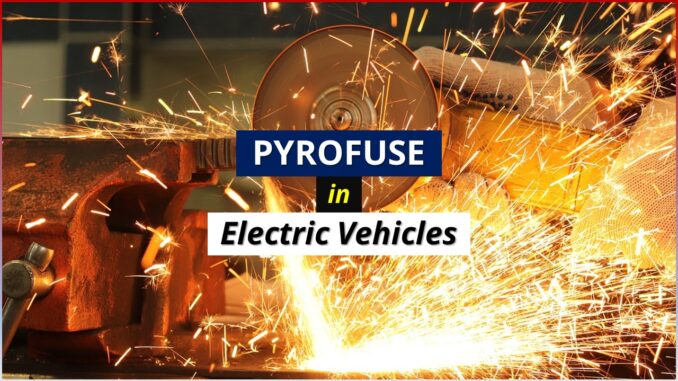
The safety of electric vehicles during abnormal conditions is ensured with the help of many systems. One of the commonly used devices to protect EVs from fire and short circuits is the pyrofuse in electric vehicles.
In this blog post, we are going to discuss
- What is a pyrofuse in electric vehicle?
- What is the use of pyrofuse
- How does a pyrofuse work?
What is pyrofuse in electric vehicles?
Pyrosfuse is a fast-acting explosive fuse used to permanently disconnect high-voltage batteries from the circuit during major accidents.
Pyrotechnic Safety Switches (PSS) are activated by the airbag control device or BMS and securely and reliably break the circuit before a short-circuit may occur due to vehicle deformation.
The pyrotechnic-driven PSS disconnection systems employ airbag initiators.
The controller regularly checks the operation of the whole initiation circuit, including the line and initiator. Disconnection occurs without the use of any other external help after the initiating pulse.
All vehicle manufacturers prioritize security problems, and as a result, many sensors, fuses, and switches are installed in passenger cars and commercial vehicles to guarantee optimum protection for the automobile and its driver with their brands.
Importance of Pyrofuse in Electric Vehicles
DEKRA, a European vehicle inspection company, conducted a study on the impact of significant vehicle body deformation after accidents. Through their analysis, it was revealed that nearly 90% of road collisions at speeds exceeding 80 km/h lead to subsequent fires.
This is primarily attributed to the extreme deformation that triggers an electrical fault in the thickest conductor, namely the cable connecting the battery to the starter/generator.
Typically, the starter/generator cable is inadequately protected within wire harnesses. In the event of a catastrophe, these exposed or damaged wires can pose short-circuit risks for both passengers and rescuers.
Short-circuits may cause direct ignition, and the resulting sparks or arcs can generate smoldering fires due to the intense heat produced.

However, the primary ignition source in the vehicle is the battery itself, as its stored electrical energy significantly contributes to becoming the main ignition factor.
Therefore, DEKRA’s research emphasizes the importance of addressing these issues to mitigate the risks associated with post-accident fires and the potential hazards posed by hot engine components and the battery’s stored electrical energy.
What is the use of pyrofuse in electric vehicles?
In electric vehicles, pyrofuses are commonly used as part of the electrical protection system. A pyrofuse is a fuse that utilizes pyrotechnic elements to disconnect the electrical circuit in case of a fault or overcurrent condition.
It is designed to rapidly and safely interrupt the flow of current to protect the vehicle’s electrical components and prevent potential hazards such as fire or damage to the battery system.
Pyrofuses are typically employed in high-voltage systems of EVs, including the battery pack, motor controller, or other critical components.
In the event of an electrical fault, such as a short circuit or excessive current, the pyrofuse is triggered, usually by an electrical signal, which activates the pyrotechnic element to quickly interrupt the circuit.
How does pyrofuse work?
These fuses get activated with the conditions that trigger airbags. The trigger signal to the fuse ignites an explosive that opens the fuse. Once the trigger is sent to the fuse then it operates itself even though the triggering circuit is damaged.
It has been demonstrated a million times. In pyrotechnic-driven PSS disconnection systems, airbag initiators are employed.
The controller regularly checks the operation of the whole initiation circuit, including the line and initiator. Disconnection occurs without the use of any other external help after the initiating pulse.
Pyrotechnics speeds the separation piston by triggering it through the airbag ECU or the battery management system BMS.
The bus bar is cut in less than 0.1 milliseconds, while the electrical connections are separated in less than 0.20 milliseconds.
The plastic piston separates the bus bar ends, preventing an electric arcing effect and sparing the electrical components from additional damage.
Advantages of using pyrofuse in electric vehicles
#1 Overheating Protection
The primary advantage of pyrofuse is its ability to protect against overheating. When the temperature exceeds a specific threshold, the pyrofuse activates and cuts off the electrical current. This helps prevent damage to the device or potential fire hazards caused by excessive heat.
#2 Quick Response
Pyrofuse has a rapid response time, meaning it reacts swiftly to changes in temperature. This ensures prompt action to disconnect the power when overheating occurs, minimizing the risk of damage or injury.
#3 Reliable Operation
Pyrofuse offers reliable and consistent operation, providing a dependable safety mechanism. It is designed to respond consistently to temperature changes and provide protection over multiple heating cycles.
#4 Low Maintenance
Once a pyrofuse is tripped due to overheating, it typically requires replacement. However, these devices are relatively inexpensive and easy to replace, requiring minimal maintenance.
#5 Compact Design
Pyrofuses are compact and can be integrated into various devices without adding significant bulk or complexity. Their small size allows for flexible installation and compatibility with different applications.
#5 Cost-Effective
Pyrofuses are cost-effective safety devices compared to other complex protection mechanisms. They offer a simple and efficient solution to prevent overheating, reducing the risk of damage to electrical equipment and potential hazards.
Conclusion
We discussed “What is pyrofuse in electric vehicles?”, “How does it work?” and more here. The use of fast-acting fuse helps to enhance the safety of electric vehicles during road accidents and other hazards.